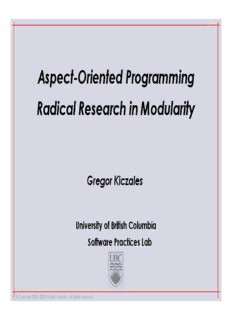
Aspect-Oriented Programming Radical Research in - Usenix PDF
Preview Aspect-Oriented Programming Radical Research in - Usenix
Aspect-Oriented Programming Radical Research in Modularity Gregor Kiczales University of British Columbia Software Practices Lab © Copyright 2004-2006 Gregor Kiczales. All rights reserved. Expressiveness • The code looks like the design • “What’s going on” is clear • The programmer can say what they want to Programs must be written for people to read, and only incidentally for machines to execute. [SICP, Abelson, Sussman w/Sussman ] Radical Research in Modularity 2 Share An Emerging Debate • About modularity and abstraction – foundational concepts of the field – but perhaps built on invalid implicit assumptions • generality of hierarchy • dynamicity of software configurations • source to machine code correspondence • developer’s sphere of control • Consider these definitions: A module is a localized unit of source code with a well-defined interface. Abstraction means hiding irrelevant details behind an interface. Radical Research in Modularity 3 Simple Drawing tool (i.e. JHotDraw) Radical Research in Modularity 4 Key Design Elements • Shapes – simple (Point) – compound (Line…) – display state – displayed form • Display • … • Display update signaling – when shapes change – update display – aka Observer Pattern Radical Research in Modularity 5 Using Objects • Shapes • Display • Update signaling * Display Shape moveBy(int, int) Point Line 2 getX() getP1() getY() getP2() setX(int) setP1(Point) setY(int) setP2(Point) moveBy(int, int) moveBy(int, int) Radical Research in Modularity 6 Using Objects • Shapes class Point extends Shape { private int x = 0, y = 0; • Display int getX() { return x; } int getY() { return y; } void moveBy(int dx, int dy) { • Update signaling x = x + dx; y = y + dy; } void setX(int x) { this.x = x; } • Expressive void setY(int y) { – code looks like the design this.y = y; – “what’s going on” is clear } } • Modular Display * Shape – localized units moveBy(int, int) – well defined interfaces • Abstract Point Line 2 getX() getP1() – focus on more or less detail getY() getP2() setX(int) setP1(Point) setY(int) setP2(Point) moveBy(int, int) moveBy(int, int) Radical Research in Modularity 7 Using Objects • Shapes class Point extends Shape { private int x = 0, y = 0; • Display int getX() { return x; } int getY() { return y; } void moveBy(int dx, int dy) { • Update signaling x = x + dx; y = y + dy; display.update(this); } void setX(int x) { this.x = x; display.update(this); • Expressive } void setY(int y) { – Point, Line harder to read this.y = y; display.update(this); – structure of signaling } } • not localized, clear, declarative Display 1 * Shape • Modular? Abstract? moveBy(int, int) – signaling clearly not localized – Point, Line polluted Point Line 2 – revisit this later getX() getP1() getY() getP2() setX(int) setP1(Point) setY(int) setP2(Point) moveBy(int, int) moveBy(int, int) Radical Research in Modularity 8 Using Aspect-Oriented Programming * Display Shape 1 moveBy(int, int) ObserverPattern Point Line 2 getX() getP1() getY() getP2() setX(int) setP1(Point) setY(int) setP2(Point) moveBy(int, int) moveBy(int, int) Radical Research in Modularity 9 Using Aspect-Oriented Programming aspect UpdateSignaling { private Display Shape.display; pointcut change(): call(void Point.setX(int)) || call(void Point.setY(int)) || call(void Line.setP1(Point)) || call(void Line.setP2(Point)) || call(void Shape.moveBy(int, int)); after(Shape s) returning: change() 1 && target(s) { s.display.update(); } } Display * Shape moveBy(int, int) ObserverPattern Point Line 2 getX() getP1() getY() getP2() setX(int) setP1(Point) setY(int) setP2(Point) moveBy(int, int) moveBy(int, int) Radical Research in Modularity 10
Description: